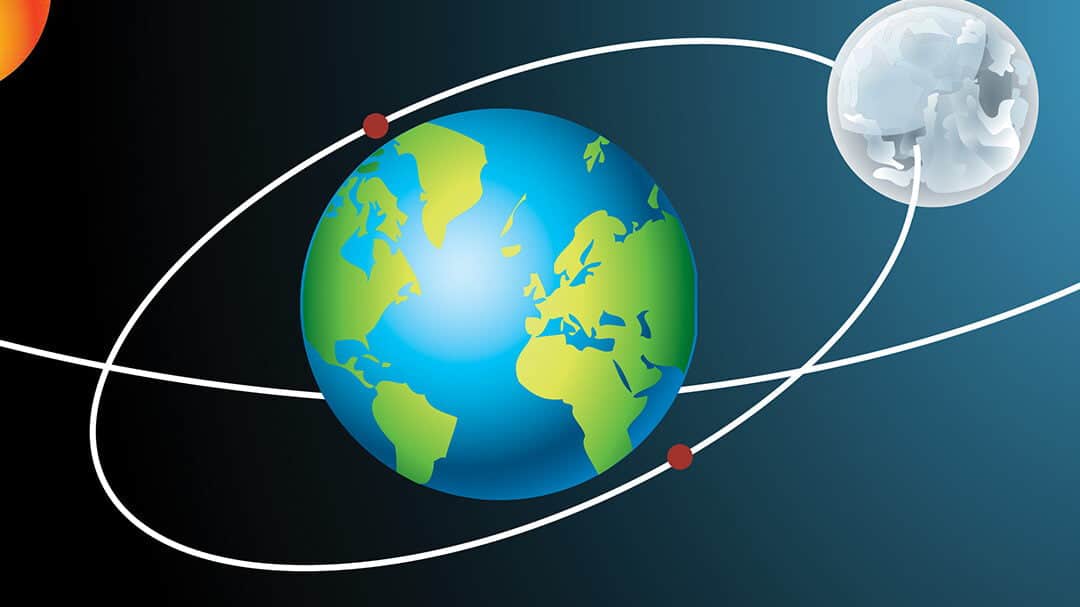Is it true that the moon does not spin on its axis? This question has been debated by scientists for years, but a universally satisfying answer has yet to be found. Various hypotheses have been proposed and attempts have been made to prove them. Currently, there is still a contentious situation surrounding this issue.
The Appearance of the Moon
The examination of the Moon’s surface is of immense fascination to the scientific community. Scientists investigate it in conjunction with the Earth, perceiving them as a unified system.
As the Moon orbits around the Earth, its position in relation to the Sun also shifts. Our planet always sees the same side of the Moon, while the line that divides the two halves is referred to as the terminator. As a satellite, the Moon follows an elliptical orbit.


While orbiting around the Earth, the Moon’s illuminated side appears to change its shape. However, the celestial body maintains its round shape at all times, and the perception of its shape changes due to the varying angle at which sunlight falls on its surface. Throughout the lunar month, the Moon is observable from Earth from various angles. The key ones include:
During a new moon phase, the Moon is not visible in the sky as it is positioned between the Sun and the Earth. Sunlight does not reach the Moon and, consequently, does not reflect off its surface, resulting in its unilluminated half being invisible from Earth.
During the first quarter, the Sun illuminates the right side of the Moon as it is positioned at an angular distance of 90 ° from the Sun. In the last quarter, the situation is similar, but this time the left side is illuminated.
When it comes to the fourth phase – the full moon, the Moon is in opposition to the Sun, causing it to reflect the entire amount of light that falls upon it. As a result, from Earth, we are able to see the entire illuminated half of the Moon.
Planet Earth
In the 16th century, it was already established that the Earth rotates on its axis. However, the origins of this rotation and what came before it remain a mystery. There are several theories attempting to explain this phenomenon. One theory suggests that during the formation of planets, dust clouds came together and formed the Earth, while simultaneously attracting other celestial bodies. The collisions between these planets and other bodies could have set them in motion, and from then on, inertia took over. Although this hypothesis lacks clear confirmation, it raises another intriguing question: why doesn’t the Moon rotate on its own axis? Let’s explore this further.


Varieties of Moon Rotation
In order for a celestial body to rotate around its own axis, it must possess that axis, which the Moon lacks. This can be proven by breaking down the Moon into numerous points. As the Moon rotates, these points will trace out paths in the shape of concentric circles. This implies that all the points are involved in the rotation. If there were an axis, certain points would remain stationary while the side visible from Earth would change. However, this is not the case.
In simpler terms, the Moon does not experience centrifugal forces towards its center, hence it does not undergo rotation.
The movement of a celestial object
In order to demonstrate the rotation of the Moon, researchers employ a variety of investigative techniques. Among these is the examination of the Earth’s satellite’s motion in relation to the stars.
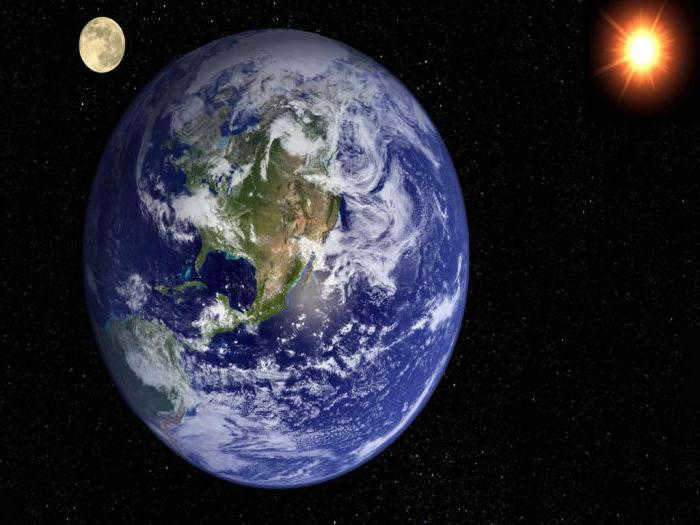
The moon is often considered a stationary object, but when counting is done, it becomes clear that the satellite actually has its own rotation in relation to the stars. While some may argue that the moon does rotate around its axis, this is actually an incorrect observation. The moon’s centripetal control is determined by the Earth, so it is important to study the moon’s relationship to our planet.
Orbit versus Trajectory
To comprehend whether the Moon undergoes rotation on its axis, let’s examine the concepts of “orbit” and “trajectory”. They can be distinguished by:
- Being a curved path with a defined starting and ending point;
- Existing as either straight or curved;
- Occurring in either a single plane or in three-dimensional space.
Why doesn’t the Moon rotate on its axis? It is understood that an object can only engage in two types of motion simultaneously. The Moon already partakes in these two allowable movements: revolving around the Earth and orbiting the Sun. Hence, there is no room for any other forms of rotation.
When observing the Moon’s trajectory from the Earth, we perceive a complex curve.
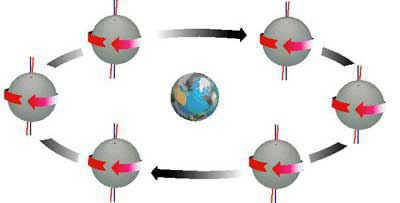
The moon’s rotation is not affected by its orbit around the Earth. The moon’s orbit is determined by the law of conservation of momentum, which states that an object in motion will continue in a straight line unless acted upon by an external force. However, the moon’s orbit can change if its momentum changes. The laws of physics govern the presence of an orbit, while the laws of mathematics describe the moon’s trajectory.
System of Earth and Moon
According to certain manuals, the Earth and Moon can be considered as a unified system. It is stated that their center of mass, which is not the same as the center of the Earth, can be mathematically determined, and it is suggested that there is rotation around this point. However, from an astrophysical perspective, there is no observable rotation around this center, as can be confirmed by using advanced specialized equipment to observe the Earth and Moon.

Is it true that the Moon does not rotate around its axis? The rotation of a celestial body can be categorized into spin-spin and spin-orbital motion. In the case of the Moon, it undergoes a rotational spin-orbital motion around an axis that passes through the center of the Earth.
From the perspective of people on Earth, they consistently observe the same side of the Moon without any changes. To validate this, one can conduct a simple experiment using a small weight.
Imagine taking a weight and attaching it to a string, then giving it a spin. In this analogy, the weight represents the Moon, and the person holding the other end of the string represents the Earth. As the weight spins, the person can only see one side of it, just like how people on Earth can only see one side of the Moon. However, if a second person were to approach from a distance, they would be able to see all sides of the weight, even though it is not rotating on its axis. The same principle applies to the Moon, as it also does not rotate on its axis.
The Era of Space Exploration
For an extended period, researchers solely focused on studying the visible aspect of the Moon. There was no means of determining the appearance of its opposite side. However, with the advent of the space age during the mid-20th century, humanity gained the ability to observe the Moon’s far side.
As it transpired, the lunar hemispheres display remarkably contrasting characteristics. Specifically, the surface of the side facing the Earth is adorned with basalt plains, while the opposite hemisphere is marked by numerous craters. These disparities continue to captivate scientists, who hypothesize that the Earth once had two natural satellites, one of which collided with the Moon and left such distinctive features on its surface.
Conclusion
The Moon is an enigmatic celestial body whose rotational behavior remains a subject of ongoing scientific inquiry. The question of why the Moon does not appear to rotate on its axis has perplexed researchers for countless years, with no universally accepted explanation. Certain scientists posit that rotation does indeed occur, but is imperceptible to the human eye due to the synchronicity of the Moon’s rotational and orbital periods around the Earth. Conversely, other experts dispute this claim and assert that the Moon solely revolves around the Sun and the Earth, without any axial rotation.
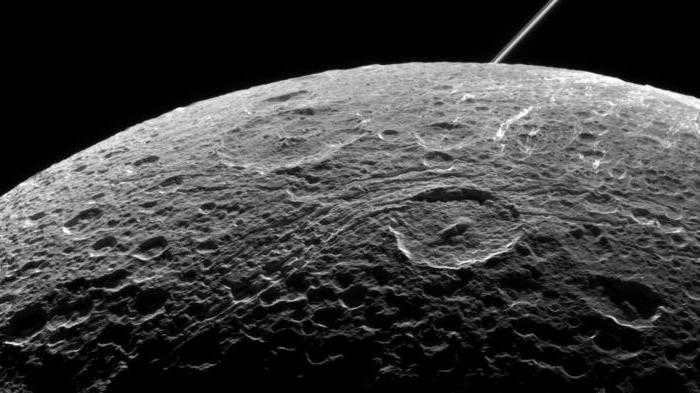
This article explores the question of why the Moon does not rotate on its axis and provides a convincing example using the concept of a weight.
The Moon is Earth’s only natural satellite and is the second brightest celestial object after the Sun. It completes a one-month orbit around the Earth, resulting in a changing angle between the Earth, Moon, and Sun. This phenomenon is responsible for the cycle of lunar phases that we observe.
Despite the fact that the Moon revolves around the Earth on its own axis, it always maintains the same face towards the Earth. The reason for this is that it completes one rotation on its axis in the same amount of time (27.3 days) as it takes to orbit the Earth. Since the directions of both rotations align, it is impossible to see the opposite side of the Moon from Earth.
In this case, the Moon’s rotation around the Earth in an elliptical orbit is uneven, allowing the Earth to see approximately 59% of its surface.
- The first spacecraft to successfully land on the Moon was called “Luna 2”. It was launched by the USSR on September 12, 1959.
- The first time a human set foot on the Moon was on July 20, 1969. It was achieved by the American astronauts of Apollo 11.
Prior to the commencement of space exploration, astronomers had already deemed the Moon to be extraordinary.
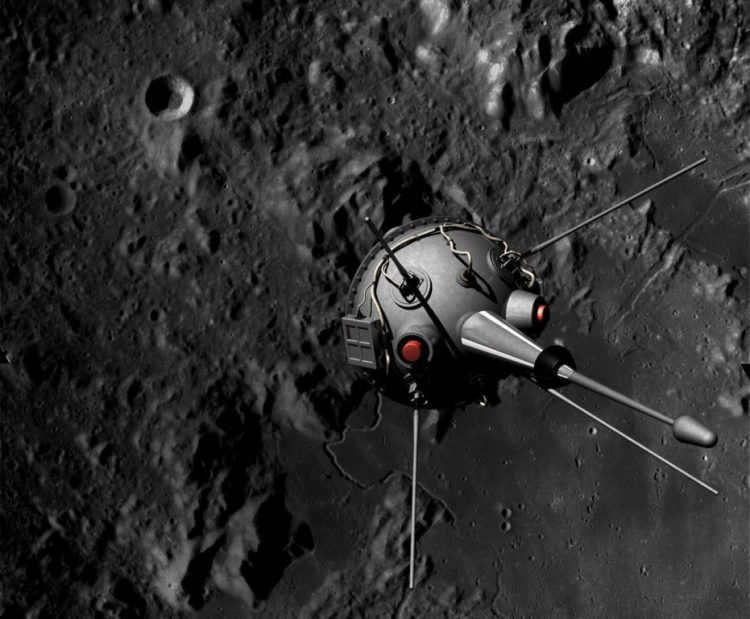
The Moon has a density that is lower than any other planet in the Earth group (Earth, Mars, Venus, Mercury) – it is only 3.3 times denser than water. This unique characteristic suggests that its formation process was unlike any other satellite.
Scientists have determined the chemical composition and age of the Moon (the oldest samples are 4.1 billion years old) by analyzing soil samples from its surface. This finding has further complicated our understanding of how this celestial body came into existence.
Currently, most experts in the field believe that the Moon was created as a result of a massive celestial body colliding with the Earth.
Comparing the Moon to Satellites of Other Planets
While not as prominent as other satellites in the solar system, the Moon holds the distinction of being the largest in proportion to its planet, which is Earth – a satellite.

The Moon is a satellite of considerable size. It ranks fifth among the 91 satellites in the solar system, being surpassed in size only by the satellites of other planets, such as Io, Callisto, Ganymede, and Titan.
The Path of the Moon
- Perigee (the point in the Moon’s orbit that is closest to Earth): 363,104 kilometers (ranges between 356,400 and 370,400 kilometers).
- Apogee (the point in the Moon’s orbit that is farthest from Earth): 405,696 kilometers (ranges between 404,000 and 406,700 kilometers).
- The average speed of the Moon’s orbit around the Earth is approximately 1,023 kilometers per second.
- The Moonmoves around the Earth in an elliptical path with a period of 27.3 days, gradually increasing its distance from Earth by 38 millimeters per year. This means its orbit is a slowly unraveling spiral.
Characteristics of the Moon’s Physical Attributes
- Surface Temperature: The Moon experiences a wide range of temperatures, from -173 °C during the night to +127 °C at sunrise. Rocks located 1 meter below the surface maintain a constant temperature of -35 °C.
- Average Radius: The Moon has an average radius of 1,737.1 kilometers, which is approximately 0.273 times the radius of the Earth.
- Surface Area: The Moon covers a total surface area of 3.793 x 107 square kilometers.
- Average Density: The Moon has an average density of 3.3464 grams per cubic centimeter.
- Acceleration of Free Fall: On the Moon, the acceleration of free fall is 1.62 meters per second squared, which is equivalent to 0.165 times the acceleration due to gravity on Earth (g).
- Mass: The Moon has a mass of 7.3477 x 1022 kilograms.
System consisting of Earth and Moon
It is not entirely accurate to discuss the movement of the Moon around the Earth. More precisely, both of these celestial bodies orbit around a central point of mass located beneath the Earth’s surface. Studies on the oscillations of the Earth revealed that the mass of the Moon is 81 times smaller than the mass of the Earth.
The gravitational force exerted by the Moon leads to the occurrence of tides on Earth.
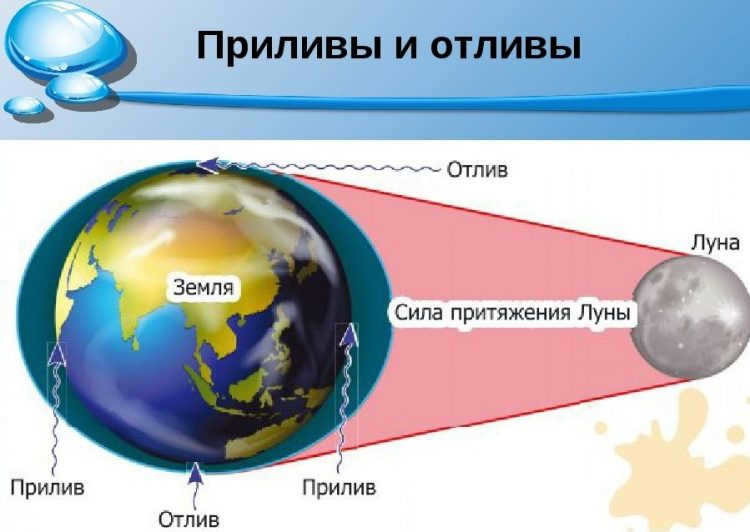
The rotation of the Earth is gradually slowing down due to the friction caused by tidal movements. This leads to an increase in the length of a day on Earth by 0.001 s per century.
As a result of this slowing rotation, the Moon is slowly moving away from the Earth while conserving the momentum of the Earth-Moon system. However, in the present era, the distance between the Earth and the Moon is actually decreasing due to the complex interactions between the Sun, the planets, and the Earth, at a rate of 2.5 centimeters per year.
On one side, the Moon always keeps the same face towards the Earth.
A thorough examination of the gravitational pull of the Moon has revealed that it is distorted towards the Earth, although the extent of this deformation exceeds what can be accounted for by the current tidal effect. This deviation is referred to as a "fixed tidal bulge", a remnant from a time when the Moon was nearer to the Earth and exerted a more substantial tidal force. However, it is also possible that this bulge signifies an irregularity in the internal composition of the Moon.
A phenomenon of the Moon’s size
When the Moon is close to the horizon, it gives an impression of being significantly larger compared to when it is higher up in the sky. This intriguing occurrence is actually an optical illusion.
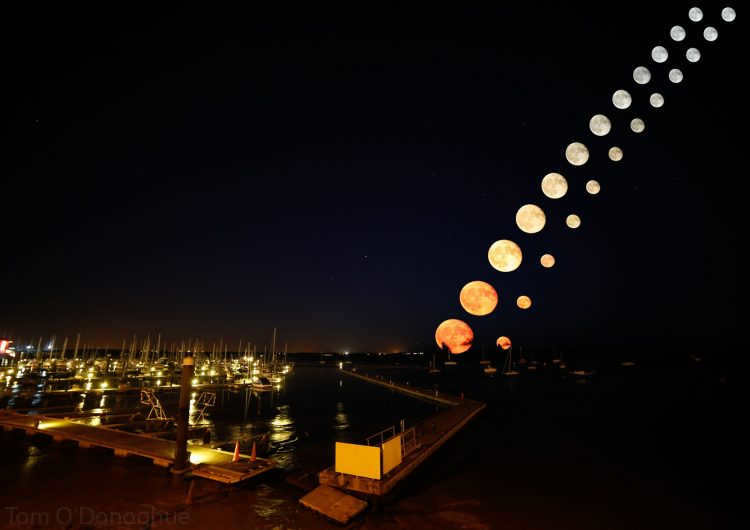
Based on psychological studies, the human mind creates its own perception of an object’s size in the subconscious, influenced by the size of surrounding objects. When the Moon is positioned higher in the sky, it appears smaller due to the vast empty space around it. However, as the Moon nears the horizon, its size becomes more easily comparable to the distance between the Moon and the horizon, resulting in an unconscious magnification of the perceived lunar size.
Alterations in the Apparent Shape of the Moon
Due to the spherical nature of the Moon, it appears to have a crescent shape when it is illuminated from the side. The side of the moon that is illuminated always faces the Sun, even if the Sun is not visible above the horizon.
The length of time it takes for the Moon to go through its complete cycle of phases (known as the synodic month) varies because of the elliptical shape of its orbit. On average, a synodic month lasts for 29 days, 12 hours, 44 minutes, and 2.82 seconds.
During the phases of the Moon that are close to the new moon (at the beginning of the first quarter and at the end of the last quarter), the crescent shape is very thin and the unilluminated part forms what is known as the ash light of the Moon. The ash light of the Moon refers to the faint glow that is visible on the Moon’s ash-colored surface, which is not directly illuminated by sunlight.
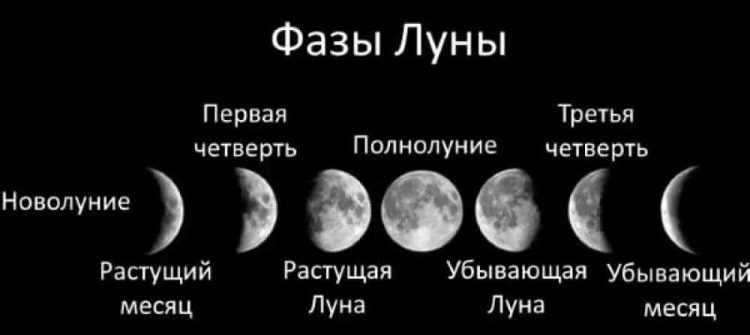
The Moon undergoes various phases of illumination:
- new moon – the phase when the Moon is not visible.
- crescent moon – the first appearance of the Moon in the sky after the new moon, taking the form of a thin crescent.
- first quarter – the phase when half of the Moon is illuminated.
- waxing moon – the phase when the Moon appears to be growing in illumination.
- full moon – the phase when the entire Moon is illuminated.
- waning moon – the phase when the Moon appears to be decreasing in illumination.
- last quarter – the phase when half of the Moon is illuminated again.
- old moon – the phase when the Moon is no longer visible.
Normally, there is typically one full moon per calendar month. However, due to the moon’s phases changing a bit faster than 12 times a year, there are occasions when a second full moon occurs in a month. These additional full moons are known as blue moons.
A helpful mnemonic for determining the moon’s phases
To differentiate between the first quarter and the last quarter, an observer located in the northern hemisphere can utilize the following mnemonic. If the moon’s crescent shape in the sky resembles the letter “C”, then it is an aging or waning moon, indicating that it is in the last quarter. Conversely, if the crescent is flipped in the opposite direction, mentally envisioning a stick attached to it, it forms the letter “P” – representing a growing moon, and therefore the first quarter.
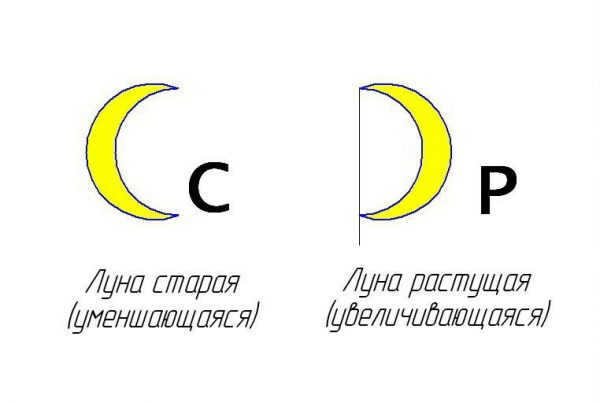
The phase of the moon can be observed in the evening when it is growing, and in the morning when it is aging.
It is important to note that near the equator, the moon is always seen “lying on its side” and this method is not suitable for determining the phase.
In the southern hemisphere, the orientation of the crescent moon in the corresponding phases is opposite: a waxing moon (from new moon to full moon) looks like the letter “C”, and a waning moon (from full moon to new moon) looks like the letter “D” without the stick.
If the front edge of the moon is illuminated in the direction of its movement, it is waxing. If it is shaded, it is waning.
The Distinction Between the Moon and the Earth
Despite the fact that there is a distance of approximately 400,000 kilometers separating the Earth and the Moon, they are intricately connected and have the ability to impact one another. The Moon interacts with every aspect of the Earth’s environment, resulting in phenomena like ocean tides. However, these two celestial entities possess several distinct characteristics that set them apart.
Comparison
The Moon is approximately 1/81 the mass of the Earth. Additionally, the Moon’s radius is roughly three and a half times shorter than the radius of the Earth.
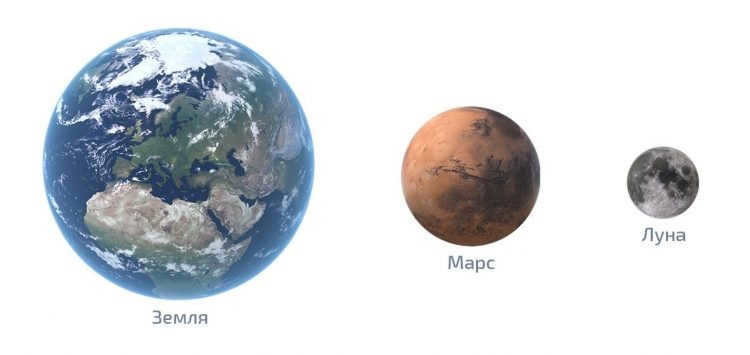
Comparison of the sizes of the Moon, Earth, and Mars
The Earth is enveloped by the geosphere, a gaseous layer containing various impurities. The Moon, on the other hand, lacks an atmosphere, oxygen, and wind. As a result, the surface of the Moon is heated up to a scorching 120°C during the day by the intense rays of the Sun, while at night it can cool down to a freezing -160°C.
Unlike the Earth, which appears bright during the day and dark at night, the Moon maintains a perpetual darkness even during the day. The sky is always black and devoid of clouds. When the Sun is shining brightly, the Moon’s sky is adorned with countless stars. From the perspective of Earth, the sky appears blue due to the scattering of the sun’s rays, which obscures the visibility of stars during daylight hours.
The Earth reflects sunlight about 50 times more intensely than the Moon.
Seas and oceans make up the majority of the Earth, with continents and islands comprising a smaller portion. The lunar surface, on the other hand, is characterized by mountainous terrain and lunar seas, which are large craters filled with hardened lava.
The lunar mountains are believed to have been formed as a result of massive meteorite impacts, whereas the mountains on Earth are the product of tectonic activity.
On the Moon, there is a layer of rocky debris and fine dust known as regolith. This regolith can be several tens of meters thick.
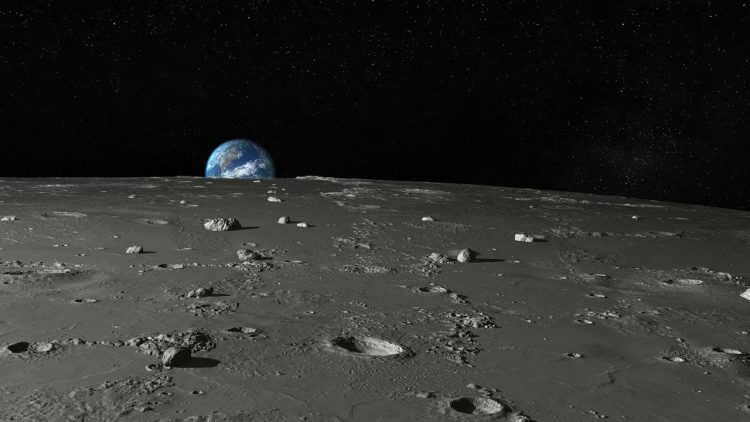
The Moon lacks volcanic activity and has minimal water reserves, unlike the Earth. While the Earth’s surface experiences erosion and weathering from water and wind, the Moon’s surface remains unaffected.
The Moon possesses a significantly weaker magnetic field and only one-sixth of the Earth’s gravity.
Additionally, the chemical composition of the Earth and the Moon varies. The Earth contains a considerable amount of iron, whereas the Moon has a scarcity of it.
Summary
- The Moon is approximately 81 times lighter than the Earth.
- The Earth’s radius is roughly 3.5 times larger than the Moon’s radius.
- Unlike the Moon, Earth possesses an atmosphere, oxygen, water, and sustains organic life.
- While the sky on Earth can be bright during the day and dark at night, the Moon consistently presents a black, cloudless sky.
- The Earth reflects sunlight approximately 50 times more intensely than the Moon.
- The Earth’s surface is adorned with continents, oceans, seas, and islands, whereas the Moon features mountains and lunar seas in the form of giant craters.
- The Moon experiences only 1/6th of the gravitational force found on Earth.
- In contrast to the Earth, the Moon has a minimal magnetic (geomagnetic) field.
- The composition of the two astronomical objects varies chemically.
Video
Rotation of the Moon
From the perspective of an Earth observer, only one side of the Moon is always visible. This leads to the question of whether the Moon actually rotates on its own axis.
Moon’s Characteristics
When comparing the characteristics of the satellites in our Solar System to the planets they orbit, the Moon stands out as a unique record holder. It has a diameter that is approximately 25% of the Earth’s diameter and its mass is only 1/100th of the Earth’s mass. However, there are other satellites in the solar system that are much larger than the Moon in absolute terms.
The prevailing theory today suggests that the formation of a natural satellite around a terrestrial planet is the result of a collision between two protoplanets of different sizes. This collision caused the heavier and denser cores of the cosmic bodies to merge into a single structure, while the fragments from the outer layers of both protoplanets formed the natural satellite.
Associated with the process of formation is the presence of a higher concentration of iron in rocks found on Earth and the prevalence of rocky material in the composition of lunar soil.
The Moon, our planet’s natural satellite, follows an elliptical path as it orbits around the Earth. The eccentricity of the Moon’s orbit, which measures its deviation from a perfect circle, is 0.0549. The average radius of the Moon is 1737.1 km, and it travels at a speed of 1.023 km/s along its orbit.
Stages of Lunar Illumination
The illumination of the Moon refers to the portion of the Moon’s surface that is visible from Earth and is bathed in sunlight. The different phases of the Moon occur as a result of the relative positions of the Sun, Earth, and Moon. As time passes, we observe different sections of the lunar disk being illuminated by sunlight from our vantage point on Earth.
Throughout the synodic month, the various phases of the Moon follow one another in sequence – starting from the new moon, when the front side of the Moon is 0% illuminated, to the full moon, when it is 100% illuminated.
Astronomers recognize four primary phases of the Moon:
Each of these phases lasts approximately 7.4 days. However, this duration is not constant and can vary due to the elliptical shape of the Moon’s orbit.
Satellite Rotation
Similar to all satellites, the Moon revolves around its host planet. Additionally, while accompanying the Earth, it orbits the Sun. The Moon’s rotational movement is not easily noticeable to an observer on Earth. Thus, it may appear as if the Moon is stationary, with the Earth rotating around it.
If the observation point is situated outside of Earth, it becomes evident that the satellite not only moves in relation to the planet but also undergoes axial rotation.
The Earth’s satellite exhibits a unique regularity in its axial rotation, as it completes one full revolution in the same amount of time it takes to orbit around the Earth. This means that in a single day, the satellite completes a full rotation around its axis.
This synchronous rotation phenomenon is not exclusive to the Earth’s satellite. Other planets also have satellites that exhibit this behavior. For example, Charon, the moon of Pluto, always shows the same side to its planet. Similarly, the moons Deimos and Phobos, which accompany Mars, also follow this synchronous rotation pattern.
Scientists refer to this phenomenon as synchronous rotation or tidal capture.
This type of rotation leads to the fact that when observing the satellite from the main celestial body, the same half of the satellite is always visible. Conversely, from the surface of the satellite itself, the main celestial body will appear to be motionless in the sky. On the opposite side of such a satellite, the “parent” celestial body will never be seen.
Scientists associate the phenomenon of tidal capture with the ability of the Moon’s rotation to impact Earth’s climate. Specifically, this phenomenon describes the presence of more atmospheric masses in the hemisphere of the planet that is facing the natural satellite during this period.
An increase in atmospheric pressure occurs in the corresponding hemisphere, leading to changes in weather conditions. Climatologists hypothesize that these “air tides” also impact the intensity of precipitation.
However, further analysis of data from the past 15 years indicates that lunar gravity affects the atmosphere to a lesser degree than previously believed by scientists.
Similarly, sea tides are generated by the gravitational field of the Moon through a similar mechanism, according to the researchers.
Sideric month vs synodic month
The Sideric month refers to the time it takes for the Earth’s satellite to return to its initial position relative to the stars after completing one revolution in its orbit. This period is not constant due to the irregularities in the lunar motion caused by the varying radius of the elliptical lunar orbit in different locations.
The duration of the Sideric month can vary by a few hours. On average, it takes 27.322 Earth days for the celestial body to complete one orbit around the Earth.
On the other hand, the synodic month, which is the time between two consecutive phases of the Moon, also does not have a constant value. The average duration of this time period is 29.5 Earth days.
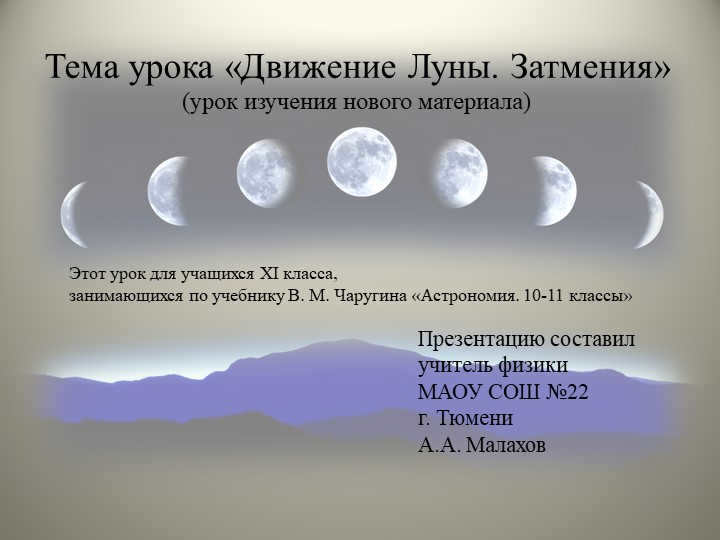
At present, 58,743 educational institutions are eligible for additional cumulative discounts ranging from 2% to 25%. To determine the specific discount applicable to all staff members of your educational institution, please access your personal Infoworks account.


We offer a professional retraining course that focuses on the theory and methodology of teaching the German language using distance technologies.
In addition to the discounts provided, we can also apply your educational institution’s discount, which will depend on the number of your colleagues who have already taken Infowork courses.
Currently, there are additional cumulative discounts available for 58,743 educational institutions, ranging from 2% to 25%. To find out the specific discount applicable to all employees of your educational institution, please log in to your personal Infoworks account.


Course for professional growth
Preventing computer addiction and promoting internet safety for children and teenagers
We can apply a discount from your educational institution to this offer (the amount of discount depends on the number of your colleagues who have completed Infoworks courses).
Currently, there are additional cumulative discounts available (ranging from 2% to 25%) for 58,743 educational institutions. To find out the specific discount applicable to all employees of your educational institution, please log in to your personal Infoworks account.


Researching contemporary international literature within the scope of an optional school curriculum, while taking into account the requirements of the Federal State Educational Standards for primary and secondary education
Explanation of the presentation slide by slide:


The subject of the lesson is “The movement of the Moon. Eclipses” (a lesson on learning new material).
The presentation was created by the physics teacher at MAOU SOSH NO. 22 in Tyumen, A.A. Malakhov.
This lesson is intended for students in the eleventh grade who are studying the textbook “Astronomy. 10-11 grades” by V. M. Charugin.
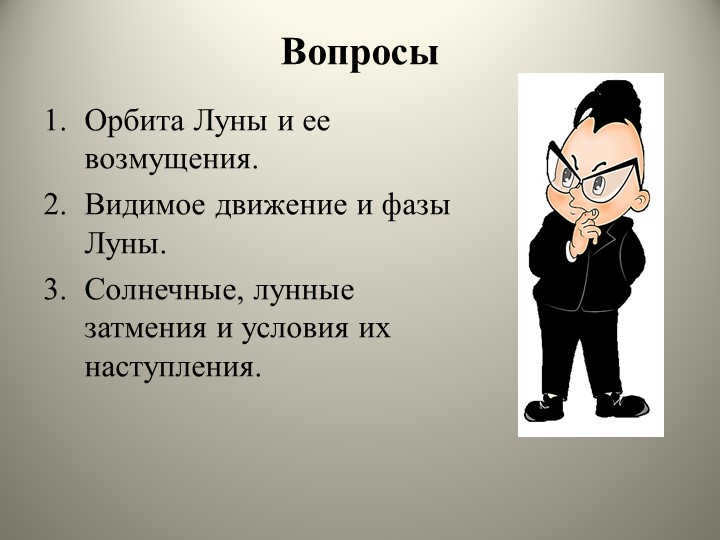

The Moon’s path around the Earth and the factors that affect its trajectory.
Observing the movement and different phases of the Moon.
Solar and lunar eclipses and the specific circumstances that lead to their occurrence.
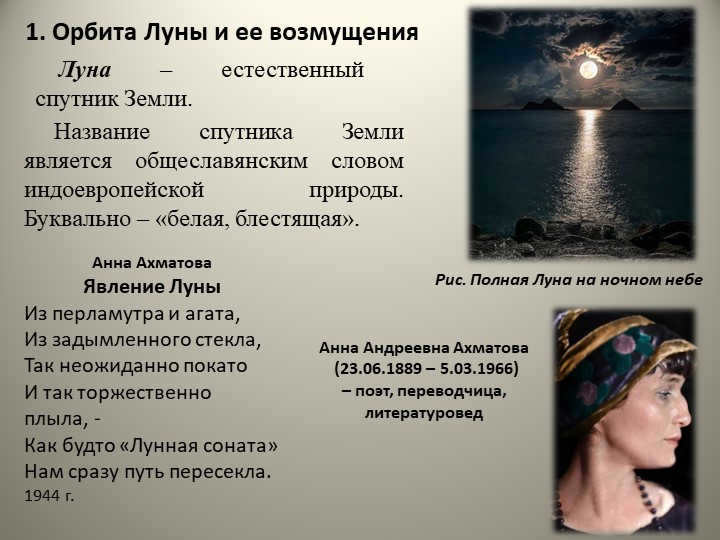

Slide 3, slide 1. The Moon’s orbit and the effects it has on the Earth’s gravitational pull.
The Moon is an Earth’s natural satellite.
The name given to the Earth’s satellite is a common Slavic word with Indo-European origins. It means “white, shiny”.
Anna Akhmatova
Apparition of the Moon
Composed of mother-of-pearl and agate,
Made of smoky glass,
It sloped unexpectedly
And floated so solemnly
“And so solemnly it floated
As if the ‘Moonlight Sonata’
Had crossed our path all at once.
1944
Anna Andreyevna Akhmatova
(23.06.1889 – 5.03.1966)
– poet, translator, literary critic.
Fig. A full Moon in the night sky.
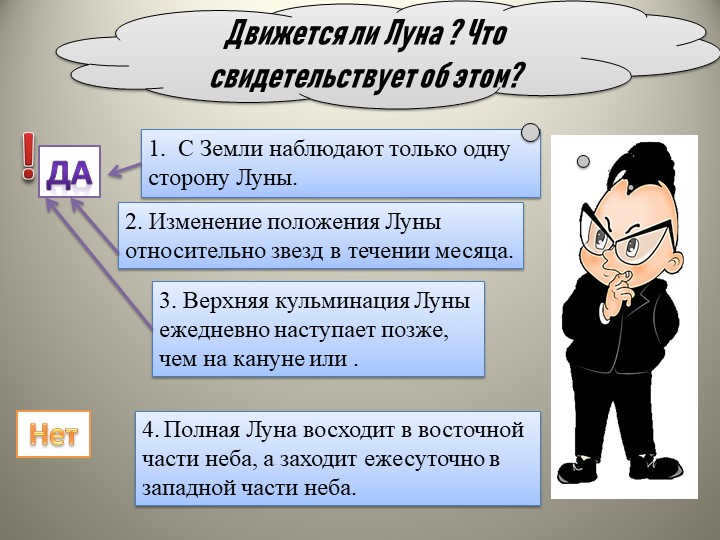

4 slide 1. The Earth only observes one side of the Moon.
Does the Moon actually move? What evidence supports this?
Yes
No
2. There is a change in the Moon’s position relative to the stars throughout the month.
4. The full Moon rises in the eastern part of the sky and sets each day in the western part of the sky.
3. The Moon’s highest point in the sky occurs later each day.
!
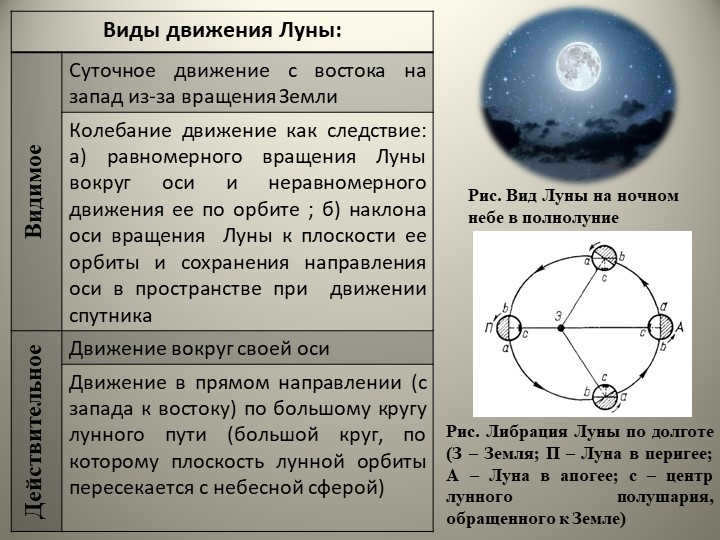
Slide number 5. The image shows the Moon in the night sky during a full moon. Also depicted is the lunar libration by longitude, with the letter Z representing the Earth, P representing the Moon at perigee, A representing the Moon at apogee, and c representing the center of the lunar hemisphere facing the Earth.
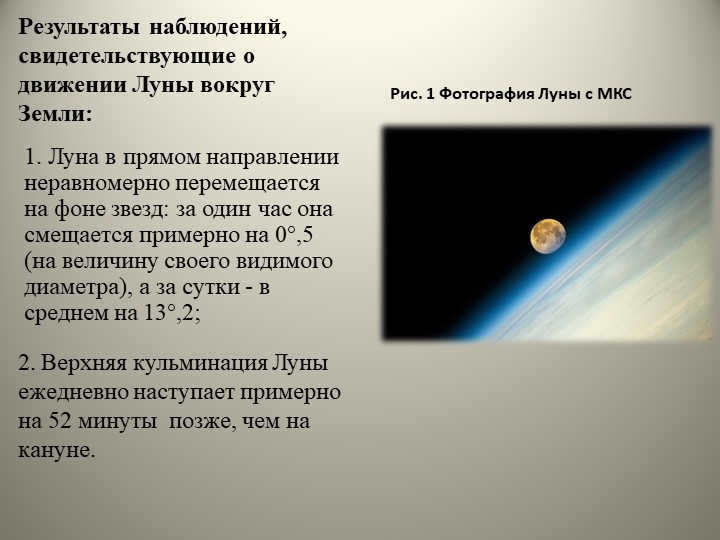
Results from observations suggest the movement of the Moon around the Earth:
1. The Moon appears to move in an irregular pattern against the backdrop of stars, covering approximately 0.5 degrees (equivalent to its visible diameter) in one hour, and an average of 13.2 degrees in a day;
Fig. 1: A photo of the Moon taken from the International Space Station
2. Each day, the Moon reaches its highest point in the sky approximately 52 minutes later than the previous day.
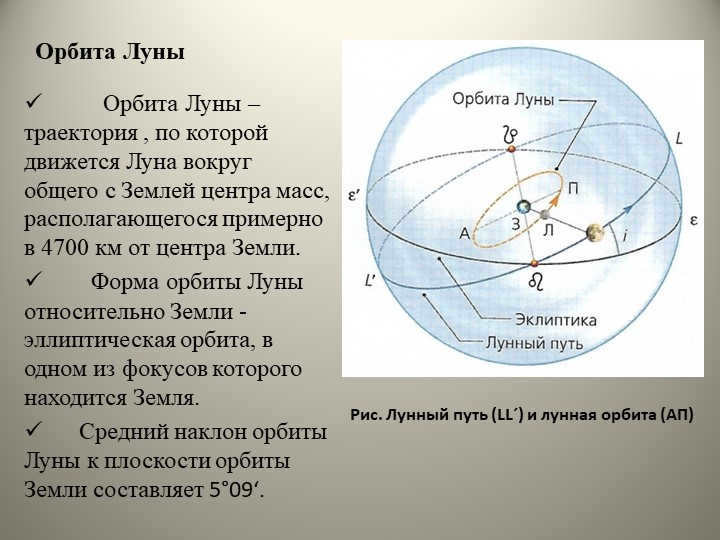

7 slide The Moon’s Path
The Moon’s path is the trajectory that the Moon follows as it revolves around a common center of mass with the Earth, which is located approximately 4700 km away from the Earth’s center.
The shape of the Moon’s path in relation to the Earth is an elliptical orbit, with the Earth being one of its focal points.
The average inclination of the Moon’s path to the plane of the Earth’s orbit is 5°09′.
Figure The lunar path (LL’) and the lunar orbit (AP)
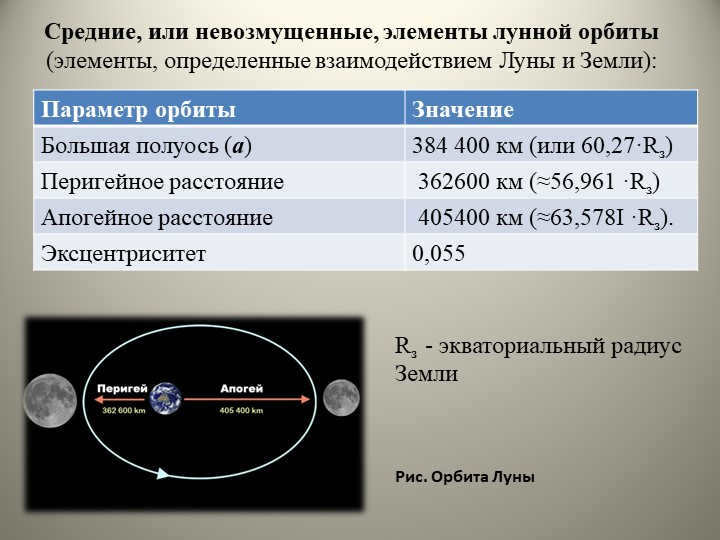
8 slide The average, or undisturbed, characteristics of the moon’s path around the Earth (characteristics determined by the interaction between the Moon and Earth):
Figure of the lunar orbit
Rz – equatorial radius of the Earth
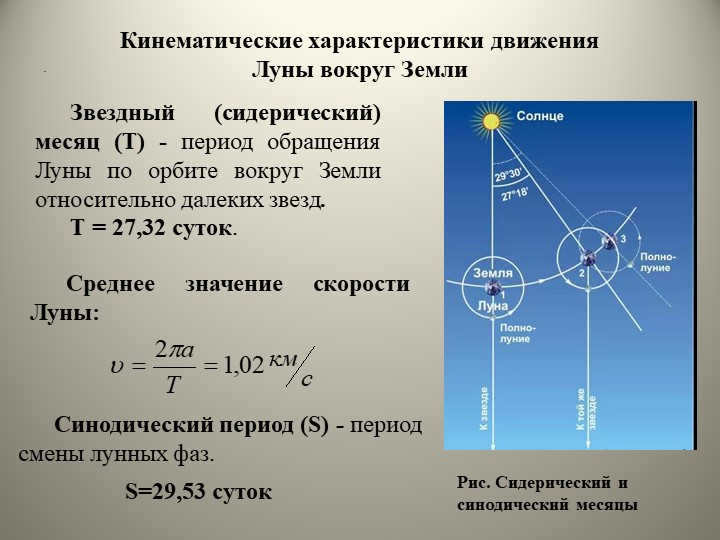

Slide 9: Kinematic characteristics of the Moon’s orbit around the Earth
Stellar (sideric) month (T) refers to the time it takes for the Moon to complete one orbit around the Earth relative to distant stars.
T = 27.32 days.
Figure: Sideric and synodic months
The average velocity of the Moon:
.
The synodic period (S) is the time it takes for the Moon to go through its phases.
S = 29.53 days
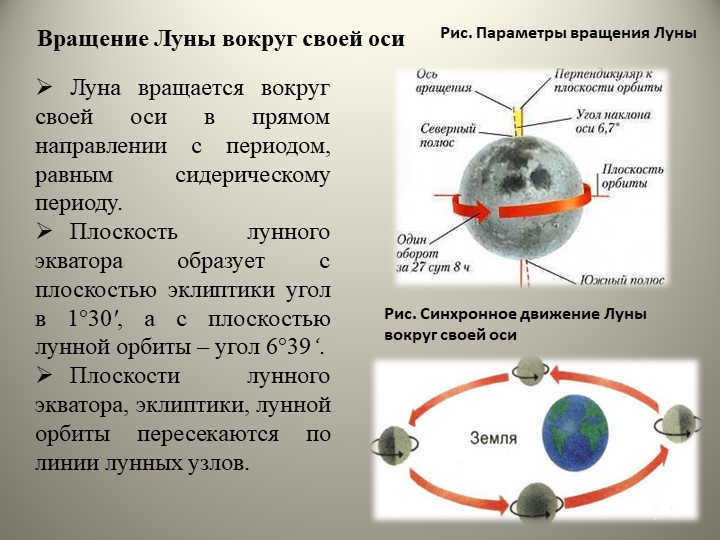

Slide 10: The Moon’s rotation around its axis
The Moon revolves around its axis in a linear path, following the sideric period.
The lunar equator is inclined at an angle of 1°30′ to the ecliptic plane and at an angle of 6°39′ to the lunar orbit plane.
The planes of the lunar equator, ecliptic, and lunar orbit intersect at the line of lunar nodes.
Figure: Parameters of the Moon’s rotation
Figure: Synchronous movement of the Moon around its axis
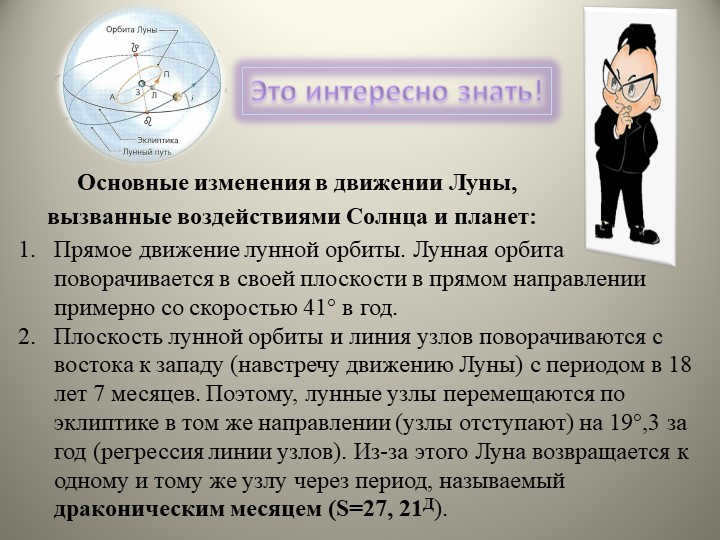

Slide 11: Notable alterations in the movement of the Moon due to the effects of the Sun and planets:
The Moon’s orbit moves in a forward direction, rotating within its plane at a rate of approximately 41 degrees per year.
The lunar orbital plane and the line of nodes also rotate from east to west (in the same direction as the Moon’s motion) over a period of 18 years and 7 months. As a result, the lunar nodes gradually shift along the ecliptic at a rate of 19.3 degrees per year (known as node line regression). This movement causes the Moon to return to the same node after a timeframe referred to as a draconic month (S=27, 21D).
Isn’t that intriguing?
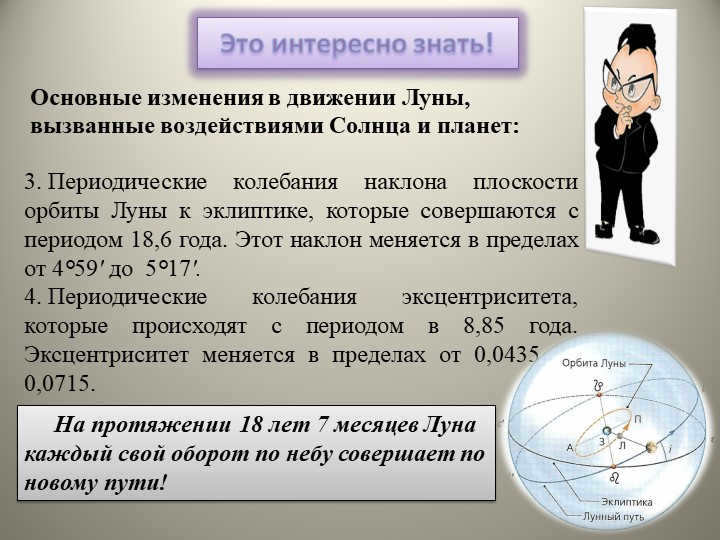

Slide 12: This is an interesting piece of information!
There are periodic variations in the inclination of the Moon’s orbital plane to the ecliptic, occurring every 18.6 years. This tilt ranges from 4°59′ to 5°17′.
There are also periodic variations in eccentricity, happening every 8.85 years. The eccentricity varies from 0.0435 to 0.0715.
The motion of the Moon is mainly influenced by the Sun and planets.
Every 18 years and 7 months, the Moon follows a new path during each revolution across the sky!
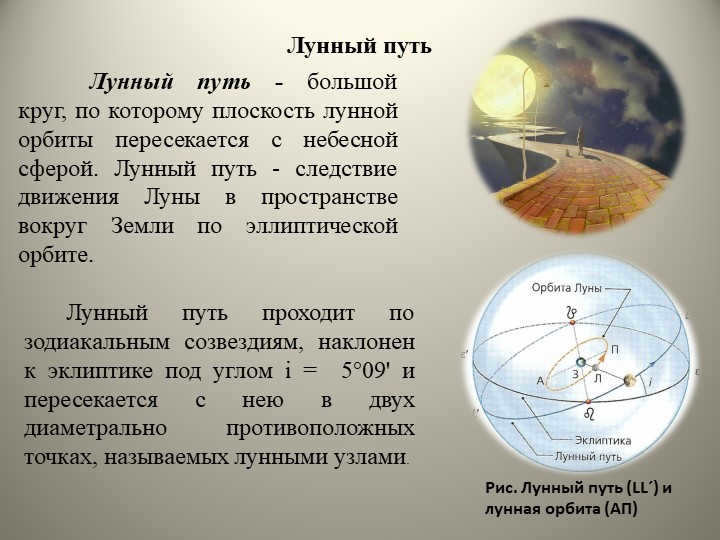
Slide 13 Lunar Path
Fig. The lunar path (LL´) and lunar orbit (AP)
The lunar path represents the intersection of the plane of the Moon’s orbit with the celestial sphere. It is a result of the Moon’s elliptical orbit around the Earth. The lunar path traverses through the zodiacal constellations and has a tilt of 5°09' to the ecliptic. It intersects the ecliptic at two opposite points known as lunar nodes.


Slide 14: Have you ever wondered why star charts only show the ecliptic and not the path of the moon? It’s an interesting phenomenon. The moon actually moves in an easterly direction against the backdrop of the stars, but it consistently sets in the western part of the sky. This peculiar behavior of the moon raises questions as to why it follows this pattern. Let’s explore this intriguing phenomenon further.
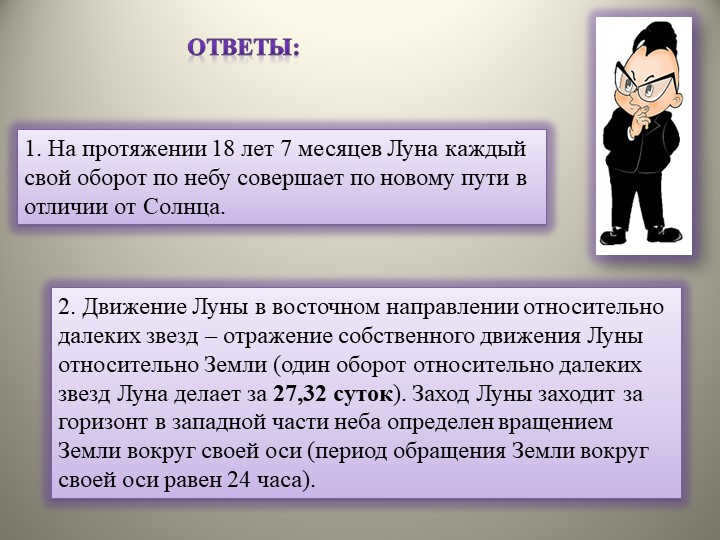
15 slide Answers:
1. Over a period of 18 years and 7 months, the Moon completes a full orbit around the Earth, following a unique path unlike that of the Sun.
2. The Moon’s movement in the eastern direction relative to distant stars is a result of its own motion relative to the Earth. It takes the Moon approximately 27.32 days to complete one revolution relative to distant stars. On the other hand, the Moon’s setting over the horizon in the western part of the sky is determined by the Earth’s rotation around its axis, which takes approximately 24 hours.
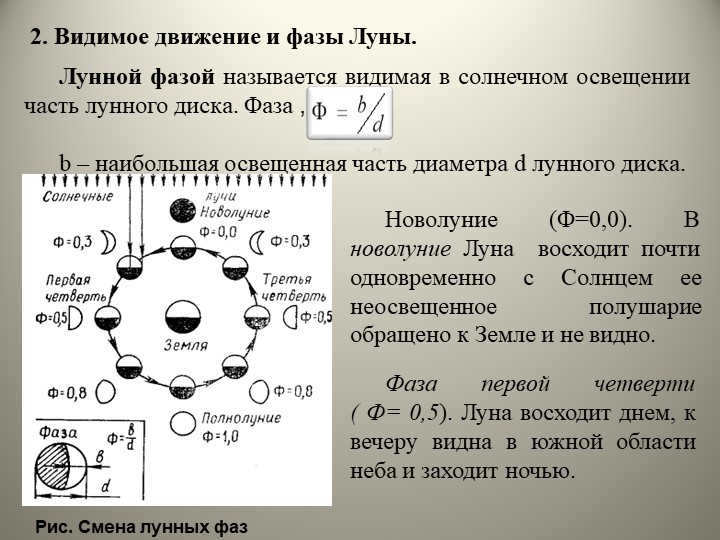

Slide 16. Motion and Phases of the Moon.
The lunar phase refers to the portion of the moon’s surface that is visible when illuminated by the sun. The phase is determined by the position of the moon in relation to the sun and the earth.
The largest illuminated part of the moon’s diameter, represented by the letter b, is known as the illuminated portion of the lunar disk.
New Moon (F=0.0). During the new moon phase, the moon rises at the same time as the sun and its unlit hemisphere faces the earth, making it invisible.
First Quarter Phase (F=0.5). The moon rises during the day and is visible in the southern part of the sky in the evening, setting at night.
Figure: Changes in lunar phases.
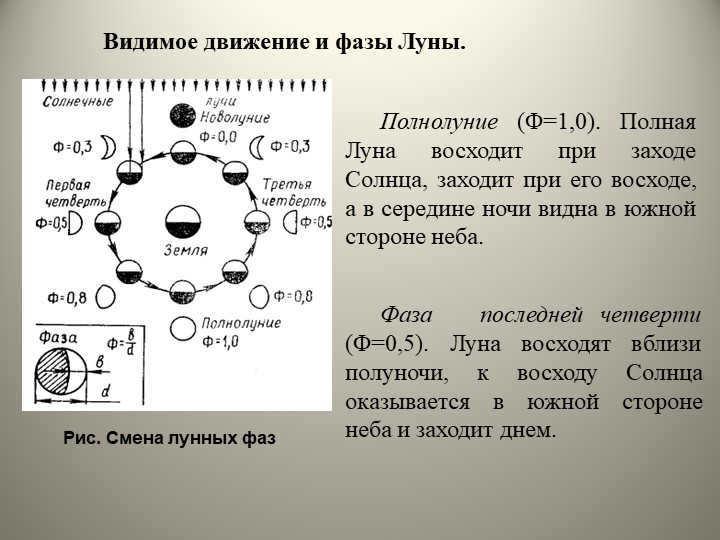
On Slide 17, we can see the change of lunar phases. The Moon goes through different phases as it orbits around the Earth. One of these phases is the Full Moon, which is represented by F=1.0. The Full Moon rises in the evening, sets in the morning, and can be seen in the southern part of the sky during the middle of the night. Another phase is the Last Quarter Phase, represented by F=0.5. During this phase, the Moon rises around midnight, is visible in the southern sky by sunrise, and sets in the afternoon.
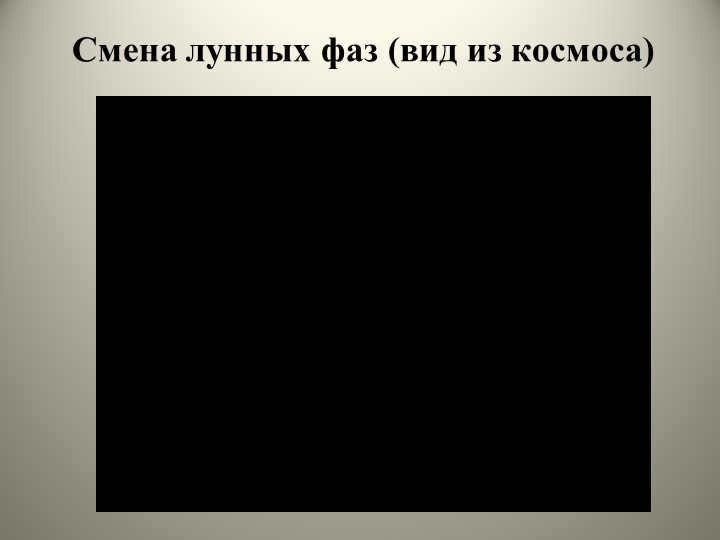
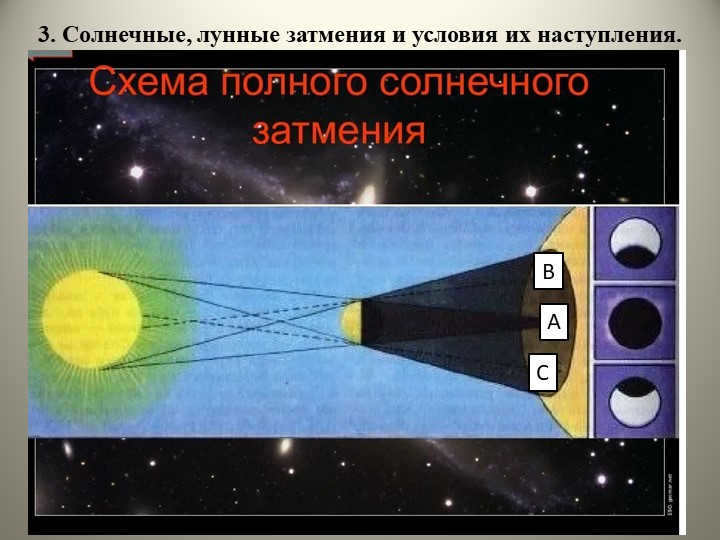
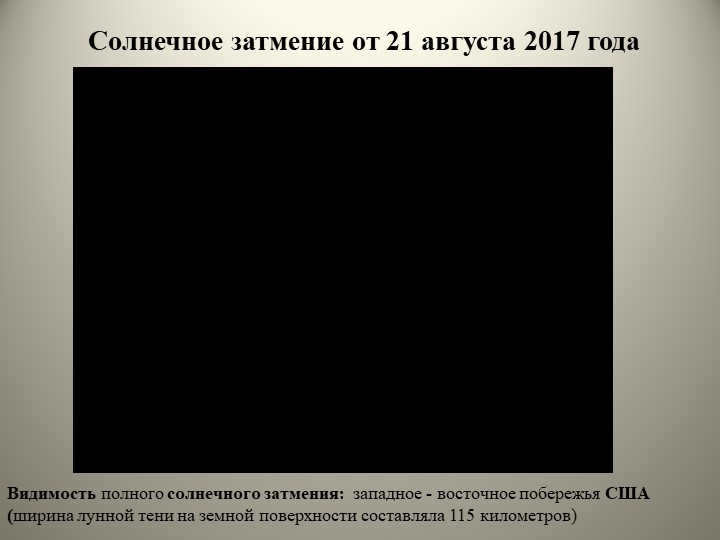
The solar eclipse that occurred on August 21, 2017, was a unique event that captivated the west to east coast of the USA. This astronomical phenomenon showcased the powerful spectacle of the Moon casting its shadow on the Earth’s surface, with a width of 115 kilometers. It was a truly mesmerizing experience for all who witnessed it.
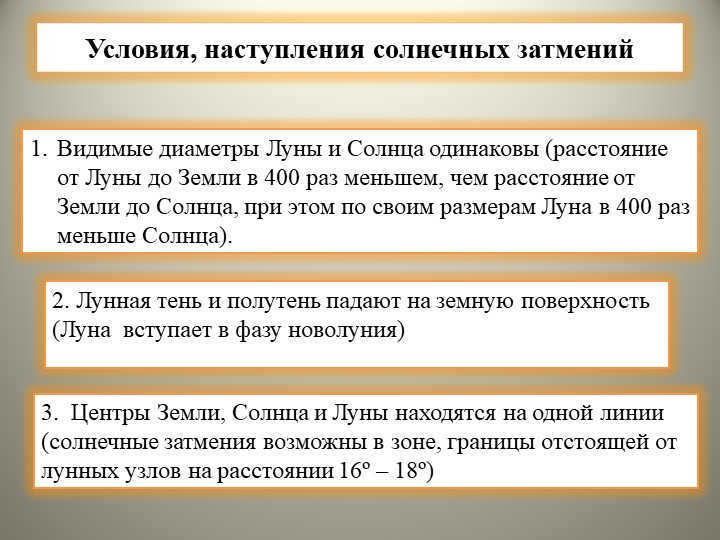

Slide 22: Conditions for the occurrence of solar eclipses
The visible diameters of the Moon and the Sun are equal. The Moon is 400 times smaller than the Sun in size, while the distance from the Moon to the Earth is 400 times smaller than the distance from the Earth to the Sun.
2. The Moon’s shadow and penumbra fall on the Earth’s surface when the Moon enters the new moon phase.
3. The centers of the Earth, Sun, and Moon align on the same line. Solar eclipses are possible in the area 16º – 18º away from the lunar nodes.
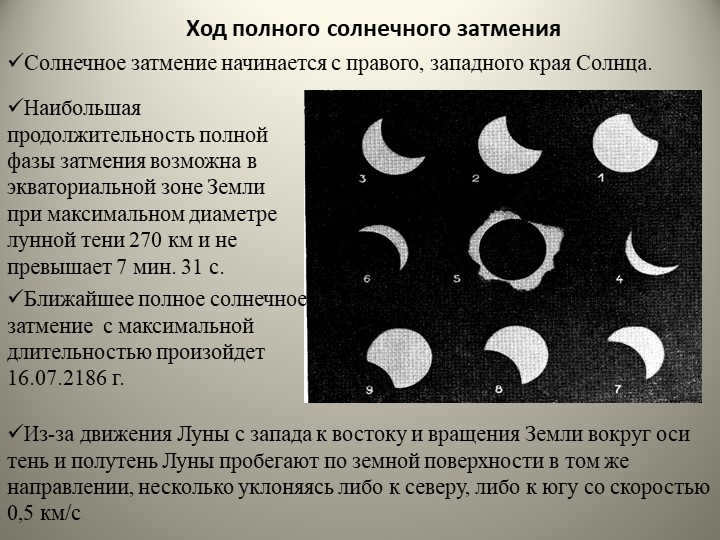

Slide 23: The path of a total solar eclipse
A total solar eclipse begins on the right, in the western part of the Sun.
The longest duration of the total eclipse phase can be observed in the equatorial region of the Earth, where the Moon’s shadow reaches a maximum diameter of 270 km and lasts for up to 7 minutes and 31 seconds.
The next total solar eclipse with the maximum duration will take place on July 16, 2186.
Due to the Moon’s eastward motion and the Earth’s rotation, the Moon’s shadow and penumbra move across the Earth’s surface in the same direction, slightly tilting either north or south at a speed of 0.5 kilometers per second.
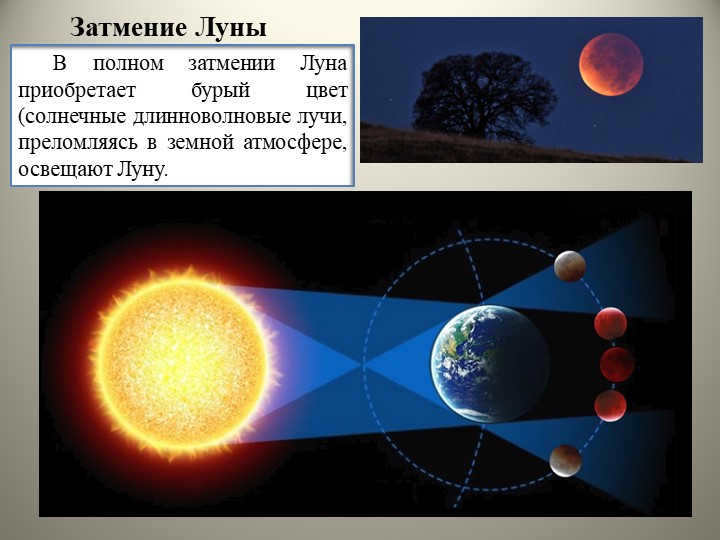
On the 24th slide, we can observe the Eclipse of the Moon. During a total eclipse, the Moon’s appearance changes to a brown color due to the refraction of the Sun’s long-wave rays in the Earth’s atmosphere, which then illuminate the Moon.
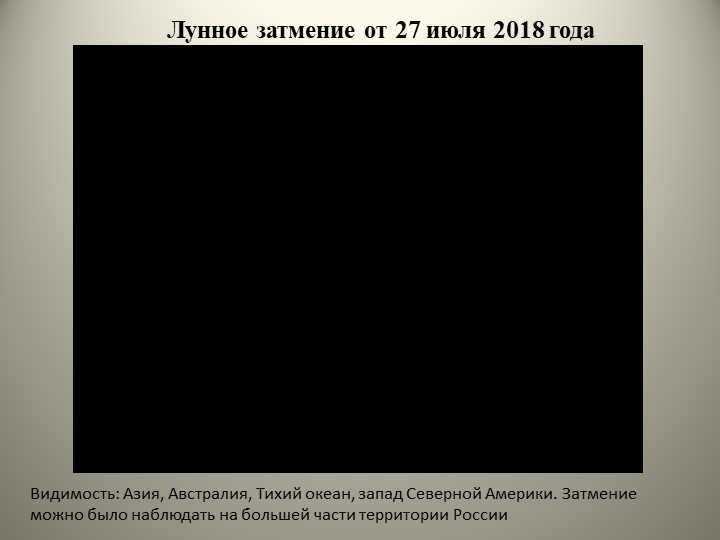
The lunar eclipse that occurred on July 27, 2018, could be seen in various regions such as Asia, Australia, the Pacific Ocean, and western North America. Additionally, it was observable in many parts of Russia.
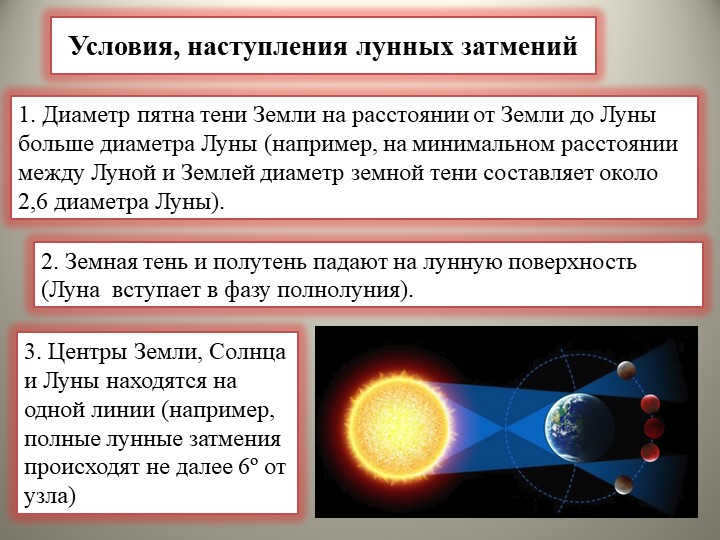

In slide number 26, we discuss the conditions and occurrence of lunar eclipses. One of these conditions is that Earth’s shadow and penumbra must fall on the lunar surface, which happens when the Moon enters the full moon phase. Additionally, for a total lunar eclipse to occur, the centers of the Earth, Sun, and Moon must be on the same line, with no more than a 6-degree deviation from the node. Lastly, the diameter of the Earth’s shadow spot at the distance from the Earth to the Moon is larger than the Moon’s diameter. For instance, at the minimum distance between the Moon and the Earth, the diameter of the Earth’s shadow is about 2.6 times the Moon’s diameter.
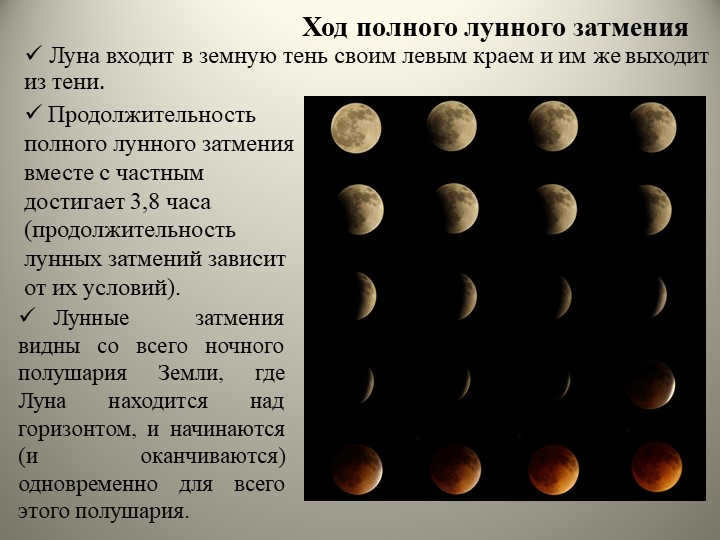

Slide 27: The path of a total lunar eclipse
The moon enters the Earth’s shadow on its left side and exits the shadow on the same side.
The total duration of a lunar eclipse, including the partial eclipse, is 3.8 hours (the duration of lunar eclipses varies depending on their conditions).
Lunar eclipses can be seen from the entire night hemisphere of the Earth where the moon is above the horizon, and they begin and end simultaneously for the entire hemisphere.
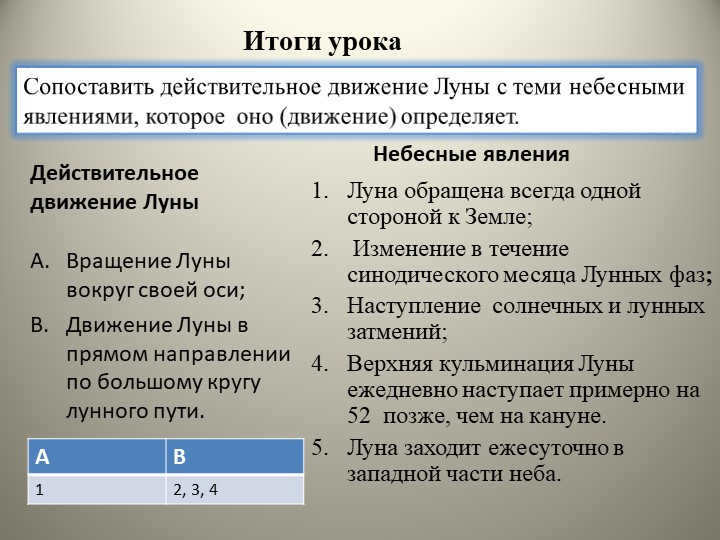
Slide 28 Summary
Actual movement of the Moon
The Moon’s rotational movement around its axis;
The movement of the Moon in a linear path along the lunar orbit.
Celestial events
The Moon always presents the same side to the Earth;
Changes during the synodic month of Lunar phases;
The occurrence of solar and lunar eclipses;
The Moon’s highest point each day is about 52 minutes later than the previous day.
The Moon sets each day in the western part of the sky.
Connect the actual movement of the Moon to the celestial events that it determines.

For your homework, you are required to complete section 6 by answering the questions and completing the assignments. Additionally, you need to prepare a report on the topic “Saros. Solar and lunar eclipses”.
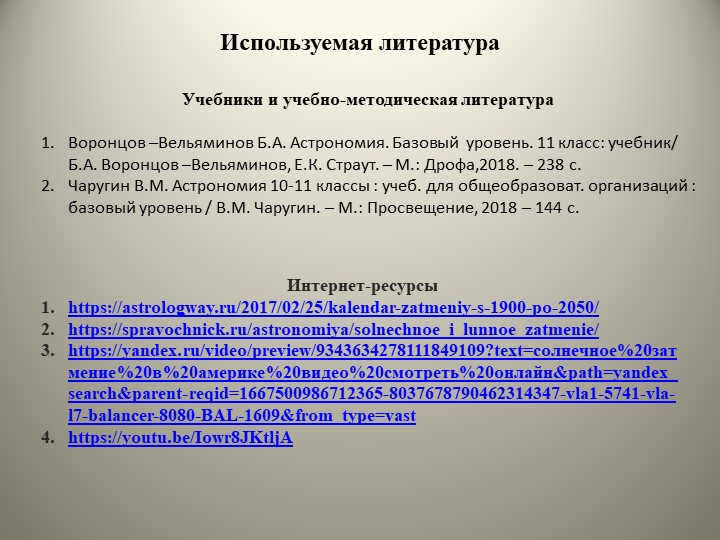
30 slides were used for the literature
Textbooks and educational-methodical literature
Astronomy by Vorontsov-Veliaminov B.A. is a textbook for the 11th grade at the basic level. It was published in 2018 by Drofa and it consists of 238 pages.
Charugin V.M. wrote a textbook for general educational organizations at the basic level for astronomy in grades 10-11. It was published in 2018 by Prosveshchenie and it consists of 144 pages.
Summary of the document:
The main objective of this lesson is to differentiate between the apparent and actual movement of the Moon. Additionally, it aims to compare the Moon’s actual (direct) movement with the celestial phenomena that it influences, as well as explore the conditions necessary for observing solar and lunar eclipses.
The Moon follows an orbit around the Earth in a forward direction, completing one revolution in approximately 27.32 days (sidereal month). It also completes one revolution relative to the Sun in about 29.53 days (synodic month). The Earth and Moon both orbit around their barycenter, which is located around 4600 km (2900 miles) from the center of the Earth, approximately 72% of the Earth’s radius. The average distance between the Earth’s center and the Moon is approximately 385,000 km (239,000 miles), equivalent to around 60 Earth radii or 1.282 light seconds.
The Moon has an average orbital velocity of 1.022 km/s (0.635 mi/s), allowing it to cover a distance equivalent to its diameter in just one hour. Unlike most satellites of other planets, the Moon’s orbit is close to the ecliptic plane rather than orbiting its primary (in this case, Earth’s) equatorial plane. The Moon’s orbital plane has an inclination of about 5.1° with respect to the ecliptic plane, while its equatorial plane is inclined by only 1.5°.
- 1 Properties
- 1.1 Elliptical shape
- 1.2 Elongation
- 1.3 Precession
- 1.4 Tilt
- 1.4.1 Nodes
- 1.4.2 Tilt toward the equator and the Moon’s immobility
- 1.4.3 Scale model
Orbit Characteristics
The information provided in this section is an approximation of the orbit characteristics. The Moon’s path around the Earth is subject to various disturbances, known as perturbations, which have been extensively studied (lunar theory) throughout history.
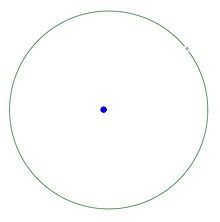 The graphic above shows the Moon’s orbit around the Earth, with the sizes of both celestial bodies accurately depicted.
The graphic above shows the Moon’s orbit around the Earth, with the sizes of both celestial bodies accurately depicted. 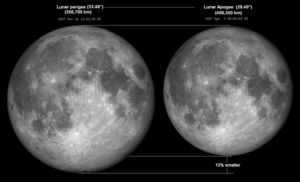 Additionally, the image compares the apparent size of the Moon at its closest point (perigee) and its farthest point (apogee).
Additionally, the image compares the apparent size of the Moon at its closest point (perigee) and its farthest point (apogee).
Elliptical shape
The Moon’s path around the Earth is not a perfect circle, but rather an elliptical shape. The major and minor semi-major axes of the ellipse are 384,400 km and 383,800 km respectively, with a difference of only 0.16%. Using the equation of the ellipse, we can determine that the eccentricity is 0.0549, and the distances from perigee (closest point to Earth) and apogee (farthest point from Earth) are 362,600 km and 405,400 km respectively, with a 12% difference.
Due to the phenomenon of closer objects appearing larger, the size of the Moon appears to change as it moves closer to or farther away from an observer on Earth. When the full Moon is at its closest point to Earth (perigee), we experience a “super Moon”. At this point, the Moon’s apparent diameter can be up to 12% larger (depending on the distance to apogee and perigee), and its apparent area is 25% larger, resulting in more light being reflected towards Earth.
The variation in the Moon’s orbital distance results in alterations in both its tangential and angular speed, as evidenced by Kepler’s second law. The mean angular displacement in relation to an hypothetical observer at the Earth-Moon barycenter is 13.176° per day in an eastward direction (J2000.0 epoch).
The smallest, average, and largest distances of the Moon from the Earth, along with its angular size as seen from the Earth’s surface, are adjusted proportionally.
Elongation
Elongation of the Moon refers to its angular distance in the eastern direction from the position of the Sun at any given time. When the Moon is in the phase of a new moon, its elongation is zero, indicating that it is in conjunction with the Sun. On the other hand, during a full moon, the elongation reaches 180 degrees, indicating that it is in opposition to the Sun. In both cases, the Moon, Sun, and Earth are almost aligned, a configuration known as syzygy. When the Moon’s elongation is at 90 or 270 degrees, it is referred to as being in quadrature.
Precession
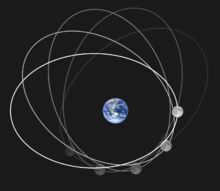 Apsidal precession refers to the movement of the major axis of the Moon’s elliptical orbit, completing one full revolution every 8.85 years…. In the accompanying image, the elliptical shape of the Moon’s orbit is exaggerated for visual purposes, as its actual shape is nearly circular.
Apsidal precession refers to the movement of the major axis of the Moon’s elliptical orbit, completing one full revolution every 8.85 years…. In the accompanying image, the elliptical shape of the Moon’s orbit is exaggerated for visual purposes, as its actual shape is nearly circular. 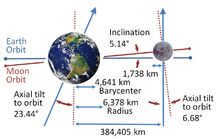 Orbital inclination – The Moon’s orbit is inclined at an angle of 5.14° to the ecliptic. The animation depicts the Moon’s orbit around the Earth, with the top view being a polar perspective and the bottom view being an equatorial perspective.
Orbital inclination – The Moon’s orbit is inclined at an angle of 5.14° to the ecliptic. The animation depicts the Moon’s orbit around the Earth, with the top view being a polar perspective and the bottom view being an equatorial perspective. 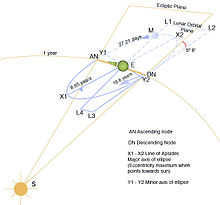 Perturbations in the Earth’s lunar orbit
Perturbations in the Earth’s lunar orbit
The position of the Moon’s orbit is not fixed in space, but it slowly rotates over time. This rotation, known as apsidal precession, causes the Moon’s orbit to change direction within the orbital plane. In other words, the axes of the ellipse that represents the orbit shift. The Moon’s major axis, which is the longest diameter of the orbit connecting the closest and farthest points (perigee and apogee), completes one full revolution every 8.85 Earth years or 3232.6054 days. This rotation occurs in the same direction as the Moon’s forward motion. It’s important to note that the apsidal precession of the Moon is distinct from the nodal precession of its orbital plane and the axial precession of the Moon itself.
Inclination
The lunar orbit’s average inclination to the ecliptic plane is 5.145°. The current inclination to the ecliptic plane is believed to have resulted from tidal evolution from an earlier orbit around the Earth that had a relatively constant inclination to Earth’s equator. The previous orbit would have required a tilt of approximately 10° to Earth’s equator to produce the current inclination to the ecliptic. Originally, it is thought that the inclination to Earth’s equator was close to zero, but it may have been increased to 10° due to the influence of planetesimals passing near the Moon as it approached Earth. If this influence had not occurred, the Moon would now be much closer to the ecliptic, resulting in more frequent eclipses.
The Moon’s orbital plane and axis of rotation do not align perfectly, resulting in a tilt of 6.688° for the lunar equator in relation to its orbit. This discrepancy was first observed by Jacques Cassini in 1722. Interestingly, the Moon’s axis of rotation precesses at the same rate as its orbital plane, but with a phase shift of 180° (as stated in Cassini’s Laws). As a result, the angle between the ecliptic and the lunar equator remains constant at 1.543°, regardless of any changes in the Moon’s axis of rotation relative to the stars.
Nodes
The points at which the Moon’s path intersects the ecliptic are known as nodes. Every 27.2122 days, the Moon passes through the same node, creating a period known as the dragon month or draconic month. The line where the two planes intersect, known as the line of the nodes, moves in a retrograde direction. From the perspective of an observer on Earth, it moves westward along the ecliptic at a rate of 19.3549° per year or 18.6 years per period. The nodes move counterclockwise around the Earth when viewed from celestial north, which is opposite to the Earth’s rotation and its orbit around the Sun. The nodes align with the Sun approximately every 173.3 days, which can result in lunar and solar eclipses. The occurrence of eclipses is also influenced by the inclination of the lunar orbit. Shadows are cast when the nodes coincide with the full and new moons, creating alignment between the Sun, Earth, and Moon in three dimensions.
Essentially, this implies that a “tropical year” on the Moon only lasts for 347 days. This is known as the dragon year or eclipse year. The Moon’s “seasons” fit into this timeframe. During roughly half of the dragon year, the Sun is positioned north of the lunar equator (although no more than 1.543°), and during the other half, it is positioned south of the lunar equator. Clearly, the impact of these seasons is minimal compared to the contrast between lunar night and lunar day. At the Moon’s poles, instead of the typical lunar days and nights lasting approximately 15 Earth days, the Sun remains “up” for 173 days, as it is “down”; polar sunrise and sunset occur for 18 days each year. Here, “up” denotes the position where the Sun’s center is above the horizon. Lunar polar sunrises and sunsets coincide with eclipses (either solar or lunar). For instance, during the solar eclipse on March 9, 2016, the Moon was near its descending node and the Sun was near the point in the sky where the Moon’s equator intersects the ecliptic. When the Sun reaches this point, its center sets at the Moon’s north pole and rises at the Moon’s south pole.
Inclination towards the equator and the Moon’s lack of movement
Approximately every 18.6 years, the angle between the Moon’s orbit and the Earth’s equator reaches a maximum of 28° 36′. This maximum angle is the result of the Earth’s equatorial tilt (23° 27′) combined with the inclination of the Moon’s orbit (5° 09′) to the ecliptic. This special event is known as the Moon’s serious quiescence. During this time, the Moon’s declination changes from -28° 36′ to +28° 36′. On the other hand, about 9.3 years later, the angle between the Moon’s orbit and the Earth’s equator reaches a minimum of 18° 20′. This is referred to as a minor lunar stop. The most recent minor lunar stop occurred in October 2015. During that time, the descending node coincided with the equinox, which is a point in the sky with zero right ascension and zero declination. The nodes gradually shift westward at a rate of approximately 19° per year. Each year, the Sun crosses this node about 20 days earlier.
When the Moon’s orbit is inclined at an angle of at least 18° 20′, the center of the Moon’s disk will be visible above the horizon every day from latitudes below 71° 40′ (90° – 18° 20′) north or south. When the tilt reaches a maximum of 28° 36′, the center of the Moon’s disk will only be visible above the horizon from latitudes below 61° 24′ (90° – 28° 36′) north or south.
At higher latitudes, there will be a period of at least one day per month when the Moon does not rise, but there will also be a period of at least one day each month when the Moon does not set. This behavior is similar to the seasonal patterns of the Sun, but occurs over a period of 27.2 days instead of 365 days. It is important to note that due to atmospheric refraction, a point on the Moon can actually be seen when it is about 34 minutes below the horizon.
Because of the angle of the Moon’s orbit in relation to the Earth’s equator, the Moon remains visible above the horizon for nearly two weeks each month at the North and South Poles, even when the Sun is below the horizon for six months. This period from moonrise to moonrise at the poles is known as a tropical month, which lasts around 27.3 days and is quite similar to the sideric period. During the winter solstice, when the Sun is farthest from the horizon, the Moon will be full when it reaches its highest point. Additionally, when the Moon is in the Gemini constellation, it will be above the horizon at the North Pole, whereas when it is in Sagittarius, it will be visible at the South Pole.
Zooplankton in the Arctic utilize the Moon’s light when the Sun remains above the horizon for months at a time. This must have been beneficial for the animals that inhabited the Arctic and Antarctic regions during periods of warmer climate.
Scaled-down replica
- This scaled-down replica portrays the Earth-Moon system, accurately representing the relative sizes and distances. It showcases the average orbital distance and the average radius of both entities.
Chronicle of observations and measurements
The observable trajectory of the Moon in the sky, visible from our planet on a nightly basis, resembles a wide ellipse, although its path is contingent upon the time of year and latitude.
The Babylonians, around 1000 BC, were the first civilization to keep permanent records of lunar observations. In what is now Iraq, clay tablets with cuneiform inscriptions have been discovered, documenting the times and dates of moonrises and moonsets, the stars the moon passed by, and the time difference between the rising and setting of the sun and the moon during a full moon. Babylonian astronomers utilized data analysis to create lunar calendars that projected far into the future, revealing the three major periods of the moon’s motion. This systematic approach to observations and predictions based on empirical data can be considered the earliest scientific study in human history. However, the Babylonians did not possess a geometric or physical interpretation of their findings and were unable to forecast future lunar eclipses, despite issuing “warnings” prior to the likely time of the eclipse.
Ancient Greek astronomers were pioneers in presenting and examining mathematical models of celestial object movement. Ptolemy formulated a precise geometric model of epicycles and ejecta to describe the motion of the Moon.
Sir Isaac Newton was the trailblazer in developing a comprehensive theory of motion, known as mechanics. The motion of the Moon was a primary benchmark for testing his theory.
Lunar periods
| Sidereal month | 27,321662 | Relative to distant stars (13.36874634 orbits around the sun) |
| Synodic month | 29,530589 | Relative to the Sun (phases of the Moon, 12.36874634 passes to complete an orbit around the Sun) |
| Tropical month | 27.321582 | Relative to the vernal point (precession ~ 26000 years) |
| Anomalistic month | 27.554550 | Relative to perigee (precessions of 3232.6054 days = 8.850578 years) |
| Dragon month | 27,212221 | In relation to the ascending node (precesses of 6793.4765 days = 18.5996 years) |
The lunar orbit is associated with several different time periods. A sidereal month, which is about 27.32 days, represents the time it takes for the Moon to make one complete revolution around the Earth relative to the fixed stars. On the other hand, a synodic month, averaging around 29.53 days, signifies the time it takes for the Moon to reach the same visual phase. This period varies throughout the year. The synodic period is longer than the sidereal period due to the Earth-Moon system moving in its orbit around the Sun during each sidereal month, requiring a longer period to achieve a similar alignment of the Earth, Sun, and Moon. Additionally, an anomalistic month, lasting about 27.55 days, represents the time between perigee. It is worth noting that the separation between the Earth and Moon plays a role in determining the strength of the lifting force of the lunar tide.
The draconic month refers to the period of time between one ascending node and the next ascending node. The tropical month, on the other hand, is the duration between two consecutive passages of the same ecliptic longitude. The last three periods slightly deviate from the sideric month.
The average length of a calendar month, which is one twelfth of a year, is approximately 30.4 days. It’s worth noting that this is not a lunar cycle, even though the calendar month is historically associated with the visible phase of the Moon.
In 2014, the Moon’s distance from the Earth and its phases were as follows: New Moon (0 phase), First Quarter (0.25 phase), Full Moon (0.5 phase), and Last Quarter (0.75 phase).
Tidal changes
It is the gravitational force exerted by the Moon on the Earth that causes the occurrence of tides in the sea, with the Sun having a lesser effect on tides. If the Earth had a uniform ocean of the same depth, the Moon would cause both the solid Earth and the ocean to deform in the shape of an ellipsoid, with the highest points being located approximately under the Moon and on the opposite side of the Earth. However, due to the presence of continents, the Earth’s faster rotation, and the varying depth of the ocean, this simplified representation does not accurately depict the actual phenomena. While the period of tidal flow is generally in sync with the Moon’s orbit around the Earth, the specific timing of tides can vary significantly. Certain locations on Earth may experience only one tide per day, while others, like Southampton, may experience four tides, although this is quite uncommon.
Due to the rotation of the Earth, conditional tidal bulges are carried forward by the continents in relation to the Earth and the Moon. Each bulge exerts a slight gravitational pull on the Moon, with the bulge on the side closest to the Moon being pulled slightly ahead of the Moon’s orbit (because the Earth’s rotation has moved the bulge forward). The bulge on the side farthest from the Moon has the opposite effect, but the gravitational pull is stronger for the bulge on the near side due to the inverse square law. As a result, some of the Earth’s rotational momentum is gradually transferred to the rotation of the Earth-Moon pair around their common center of mass, known as the barycenter. This increased orbital angular momentum leads to a yearly increase in the Earth-Moon distance of approximately 38 millimeters. The conservation of angular momentum means that the axial rotation of the Earth is gradually slowing, resulting in a lengthening of the day by about 23 microseconds each year (excluding glacier rebound). These figures are applicable only to the current arrangement of the continents. Tidal patterns from 620 million years ago suggest that over hundreds of millions of years, the Moon has been receding at an average rate of 22 mm (0.87 inches) per year (2200 km or 0.56% of the Earth-Moon distance per hundred million years), and the day has been lengthening at an average rate of 12 microseconds per year (or 20 minutes per hundred million years), which is about half of their current values. The current high speed may be due to resonance between natural ocean frequencies and tidal frequencies. For a more detailed explanation, see also tidal acceleration.
The Moon is gradually shifting away from the Earth, moving into a higher orbit. Scientific calculations predict that this process will continue for approximately 50 billion years. Eventually, the Earth and Moon will reach a state of mutual spin-orbit resonance, also known as tidal locking. At this point, the Moon will complete one revolution around the Earth in about 47 days (currently it takes 27 days), and both the Moon and Earth will rotate on their axes simultaneously, always maintaining a fixed position relative to each other. This phenomenon has already occurred with the Moon, which always presents the same face to the Earth, and is gradually happening with the Earth as well. However, the deceleration of the Earth’s rotation is not occurring at a rapid enough pace for the length of a day to extend to a month before other factors come into play. In approximately 2.3 billion years, the increased radiation from the Sun will cause the Earth’s oceans to evaporate, diminishing tidal friction and acceleration.
Libration
The Moon’s rotation is synchronized with its orbit around the Earth, so it always keeps the same face towards us. However, due to the elliptical shape of its orbit, the Moon’s angular velocity changes as it moves around the Earth. This means that the Moon’s rotation speed is not always the same as its orbital speed. When the Moon is closest to the Earth (at perigee), its orbital motion is faster than its rotation, causing us to see up to eight degrees of longitude of its eastern (right) back side. On the other hand, when the Moon is farthest from the Earth (at apogee), its orbital motion is slower than its rotation, revealing eight degrees of longitude of its western (left) back side. This phenomenon is known as longitudinal libration.
Due to the inclination of the lunar orbit to the Earth’s ecliptic plane by 5.1°, the Moon’s axis of rotation appears to tilt towards and away from the Earth during a complete orbit. This phenomenon, known as latitude libration, enables us to observe nearly 7° of latitude behind the pole on the far side. Furthermore, because the Moon is only 60 times the radius of the Earth away from its center of mass, an observer at the equator who watches the Moon throughout the night will move sideways by the diameter of the Earth. This leads to a daytime libration that allows us to see an additional degree of lunar longitude. Similarly, individuals located at either of the Earth’s geographic poles will witness a libration of one extra degree in latitude for the same reason.
The orbit of the Earth and Moon around the Sun
Illustration of the Earth and Moon’s paths as they orbit the Sun
When observed from the northern hemisphere (specifically, from the general direction of the star Polaris), the Moon orbits the Earth counterclockwise, while the Earth orbits the Sun counterclockwise. Additionally, both the Moon and Earth rotate counterclockwise on their own axes.
The right-hand rule can be applied to determine the direction of angular velocity. If the right thumb points towards the North Pole, the fingers curl in the same direction that the Moon orbits the Earth, the Earth orbits the Sun, and the Moon and Earth rotate on their own axes.
When depicting the solar system, it is common to illustrate the path of the Earth from the standpoint of the Sun, while the trajectory of the Moon is typically shown from the perspective of the Earth. This may create the illusion that the Moon orbits the Earth in such a manner that it occasionally moves backward when observed from the Sun’s viewpoint. However, due to the Moon’s orbital velocity around the Earth (1 km/s) being significantly smaller than the Earth’s orbital velocity around the Sun (30 km/s), this phenomenon never occurs. There are no reverse loops in the Moon’s solar orbit.
If we imagine the Earth-Moon system as a pair of planets, the center of mass is located inside the Earth, approximately 4624 km (2873 miles) or 72.6% of the Earth’s radius from the Earth’s center. This center of mass remains on the line connecting the centers of the Earth and the Moon as the Earth completes its daily rotation. The trajectory of the Earth-Moon system along its orbit around the Sun is determined by the movement of this shared center of mass. As a result, the center of the Earth moves in and out of the solar orbital path during each synodic month as the Moon orbits around the common center of mass.
The gravitational pull of the Sun on the Moon is more than double that of the Earth. As a result, the Moon always follows a curved path when viewed from a far-off vantage point outside the Earth-Moon solar orbit. This path is never concave or forms a loop. In other words, the area enclosed by the Moon’s orbit around the Sun is always convex.
Related Links
- Astronomy portal
- Ernest William Brown
- Double planet
- List of orbits
- ELP2000
- Ephemerides
- Ephemerides of the Jet Propulsion Laboratory development
- Lunar distance (astronomy)
- Lunar Laser Distance Experiment
- Lunar phase
- Lunar theory
- Milankovitch cycles
- Orbital elements
- Supermoon

